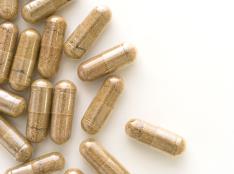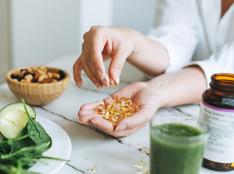Known as "The Muscle Chef", Filippone has put together this list of 20 foods and ingredients that he recommends for those interested in building muscle and staying toned.
Want more help managing your food intake? Make sure to download athleats, a mobile app that tracks everything you need to know about your nutrition.
Olive Oil
1 of 21
To help keep the body lean, replace all your cooking oils and animal fats with extra virgin olive oil. Olive oil contains fat, but it's the "good monounsaturated fat, which has been shown to raise serotonin, a hormone associated with satiety, in your blood levels. You'll feel fuller after a meal prepared with olive oil - which will help keep you from indulging in extra calories at mealtime.
Find More
Health TipsAvocado
2 of 21
Great as a spread on sandwiches (replacing butter and margarines) the avocado is a terrific source of potassium, which regulates water balance and assists recuperative powers for athletes. Also rich in healthy monounsaturated and oleic fatty acids, there's even evidence to suggest these fats help the body absorb other the nutrients available in the dishes you pair the avocado with.
Find More
Health TipsLentils and Legumes
3 of 21
As fitness fanatics who try to eat healthy, we all know protein is a challenge to keep in our diets. Fortunately, lentils and other beans are protein powerhouses that can help build and maintain muscles. One cup of the cooked beans contains 12 to 18 grams of protein and useful, slow digesting, fiber based carbohydrates that keeps blood sugars from spiking. Mix them with your salads or use as a side dish.
Find More
Health TipsKale
4 of 21
It's been getting all the attention and some dismiss it as a fad diet food, but there's no denying kale knocks it out of the park when it comes to keeping weight down and muscle development up. Kale not only contains protein, and a significant amount of iron, a mineral key to muscle development, it's also rich in vitamin K, which fights inflammation and protects against stiff joints.
Find More
Health TipsQuinoa
5 of 21
Quinoa is another health food that's been garnering a lot of attention. It's great to eat before or after a workout because of its slow-burning complex carbs, significant protein content and rich levels of lysine, an amino acid that assists the body in tissue and muscle repair. What's more, rich magnesium content improves blood circulation to your muscles, which will lower the risk of cramping and develops healthier tissues.
Find More
Health TipsSeeds and Nuts
6 of 21
Seeds are rich in amino acids, which your muscles use to gain power and tone up. They're also a wonderful source of plant-based protein. I sprinkle these on salads, cereals, yogurts and add them to certain dishes (especially a stir-fry) where they provide interesting textures. Work seeds and nut into your diet, a handful at a time, and you'll start seeing improved performance and a healthy glow.
Find More
Health TipsSpinach
7 of 21
Here's another versatile leafy green famous for its rich iron levels that you can readily introduce to salad and cooked dishes. It's also a reliable source of magnesium, which is an essential mineral for muscle building, carb metabolism.
Find More
Health TipsBroccoli
8 of 21
President George H.W. Bush used executive privilege to avoid eating it and Seinfeld's Newman called it a vile weed, but broccoli is a super food that health savvy athletes need to embrace. Broccoli contains sulforaphane, which increases testosterone levels and staves off the retention of body fat. It also blocks certain enzymes that have been linked to joint destruction.
Find More
Health TipsYams and Sweet Potatoes
9 of 21
While they're packed with carbohydrates, they also score low on the glycemic index, which means the body uses their energy at a slow and steady rate. These potatoes go a long way towards providing athletes with a reserve of energy that lets them power through even the most challenging of workout routines.
Find More
Health TipsBerries
10 of 21
Berries contain a number of antioxidant compounds that fend off inflammation and joint pain, which is good news for those of us who put our limbs to the test every day. Working them into the diet can be a bit of a challenge. They work best when added to cereals and juiced concoctions, but I've gotten into the habit of eating them on their own as a snack alternative to the more calorie rich grapes.
Find More
Health TipsYogurt
11 of 21
Packed with protein, calcium and vitamin D, yogurt is a great addition to the workout diet. Vitamin D keeps the bones strong, which in turn helps your body sustain the muscle you've built up. I prefer Greek style yogurt, but have become increasingly wary of the "fruits" and "granolas" manufacturers have been adding. These add-ons are usually just sugary and don't add value. Also be careful of artificially sweetened yogurts.
Find More
Health TipsMushrooms
12 of 21
Mushrooms are another great source of vitamin D, which scientific studies link to increased muscle resilience and strength. They're versatile enough to include in salads, raw, or cooked in stir-fried or baked dishes. Check out your supermarket shelves for some interesting shaped, textured and tasty varieties and begin adding them to various dishes you prepare.
Find More
Health TipsTofu
13 of 21
Many of my workout partners shy away from tofu, not realizing it's nothing more than soybean, something they typically invite into their diets. Soybean contains not only high levels of plant protein, but it's also got the highest levels of leucine, an amino acid that actually speeds up the synthesis of protein, meaning you'll be building muscle more efficiently. Best of all, as a chef, I can tell you tofu is an incredibly versatile cooking ingredient that takes on the flavors of whatever you cook it with. A simple Internet search will introduce to you many simple recipes that can get you started with tofu.
Find More
Health TipsSalmon
14 of 21
As fish goes, salmon contains both high-quality protein and the omega-3 fats like EPA and DHA. These go a long way in inhibiting muscle breakdown and supporting strong blood circulation. I prefer salmon to other fish selections because it's not a bottom feeder and is less likely to contain levels of toxicity we are seeing in fish like tuna.
Find More
Health TipsBananas
15 of 21
Rich in glucose, potassium and easily digestible sugar, bananas are great to eat right before a workout. They'll prevent muscle cramping, and their low glycemic index ranking means they'll provide energy throughout your regimen. While I generally just peel and eat them raw, many of my workout buddies make them the staple ingredient in their protein shakes and smoothies. Just recently, I've been enjoying them baked as a dessert option.
Find More
Health TipsWatermelon
16 of 21
Eating watermelon has been shown to improve lipid profiles and lower fat accumulation because of its concentration of anthocyanin, a compound that mollifies fat-storage genes. It's refreshing, aides in hydration and can also help reduce muscle soreness after a strenuous workout. I usually melon ball them into a small container and use them as a pick-me up between reps.
Find More
Health TipsGrapefruit
17 of 21
Believe it or not, grapefruits are also a great source for rehydration because they're 90 percent water. We all know we burn more fat cells when we stay hydrated, but let's face it, exercise creates sweat and we lose that water continually. Get in the habit of eating a grapefruit every morning before a work out. And don't make the mistake of adding sugar to lighten up the natural tartness of this fruit. You'll soon acquire a taste for grapefruit.
Find More
Health TipsCottage Cheese
18 of 21
It's a stereotype of diet foods, but cottage cheese actually stimulates muscle development because it contains casein, a slow-digesting dairy protein and live cultures. After eating cottage cheese, your blood amino acid levels rise slowly and stay elevated. The live cultures then kick in to help you break down and digest other nutrients from your meal. So be sure to eat cottage cheese with fruits, berries, nuts or a protein source for ultimate absorption.
Find More
Health TipsPapaya
19 of 21
Every day stress stimulates our bodies to produce higher levels of a hormone known as cortisol, which in turn encourages our bodies to store cholesterol-raising fat, especially around the midsection. Vitamin C-rich foods like papaya can lower levels of coristol. So if you're specifically looking to improve toning in your mid-section, be sure to seek out papaya slices – especially on those high stress days.
Find More
Health TipsBeef
20 of 21
I encourage the eating of beef, or anything listed, in moderation, maybe once or twice a week. I try to seek balance in my diet and my life and beef is great for muscle building. It's nature's best source of creatine, an organic acid, which increases muscle mass by speeding protein to your muscles. It's also rich in CLA, an anti-inflammatory fatty acid, and provides more than one-half the recommended daily intake of protein in every four-ounce serving.







Discuss This Article